It’s been nearly twenty years since Facebook was created and changed the nature of social media forever.
In that time we’ve seen the rise of multiple social competitors, including Twitter, Instagram (now owned by Facebook), Snapchat, Vine (R.I.P), TikTok, and many others. With every addition to the market, the list of Facebook best practices has had to shift to meet the expectations of changing features and audiences.
While it may not have the virality of TikTok or the glamour of Instagram, Facebook remains an essential channel to be active on for its business and community benefits.
To get the most out of Facebook in 2023, here are 10 Facebook best practices for your brand to follow for success on the platform.
Facebook Best Practice #1: Verify your Facebook business page
This is the easiest way to distinguish your brand from the rest. Verifying your Page doesn’t just provide your business with a small blue checkmark next to your page name — it’s bigger than that. A Page verification signals to your audience that your business is the real deal, which helps build trust.
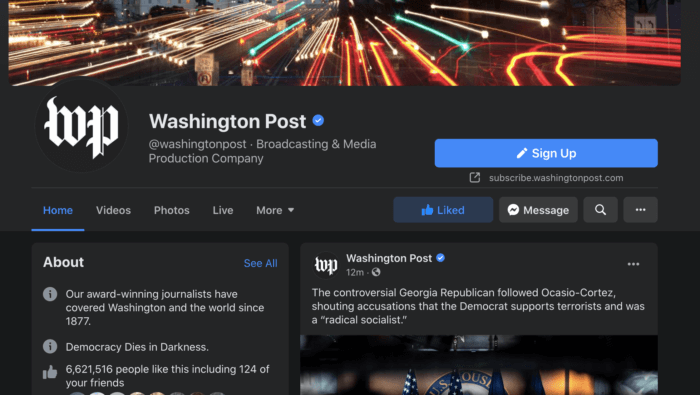
The best part is verifying your Page only requires a few steps to set you on the path to earning the coveted blue checkmark. Once you’ve completed those steps, you have one more set to go through. This process requires you to request a badge from Facebook and provide the following documents and assets:
- Photo ID (Drivers license, passport, national identification card)
- If your page represents an organization, one of the following: Phone/utility bill, certification of formation, articles of incorporation, or tax exemption documents
- Relevant URLs to your businesses’ webpage to illustrate your notability
Once you submit this information to Facebook they will make a determination as to whether your page warrants a blue checkmark or not.
In addition to the added credibility, verifying your page grants your business additional tangible benefits, such as:
- Access to new tools before they are made available to other brands
- Boosts in Facebook’s search algorithm
These added benefits put your business Page in a better position in terms of traffic and consumer confidence in your brand.
Facebook Best Practice #2: Properly size your images
Imagine sending only 60% of an email to a coworker or starting a story three chapters in without any background information. This is what it’s like to share improperly sized images on Facebook. You’re only conveying the information that is visible to the average Facebook user scrolling through their feed while leaving the rest hidden. Additionally, improperly sized images also lead to diminished quality, such as pixelation when dealing with smaller visuals.
There are specific image sizes that are optimized for maximum visibility on Facebook and tailoring your visual content to these specifications will ensure the highest levels of engagement possible.
Optimal Facebook Image Sizes:
- Profile Picture: 400 x 400 px
- Business Page Cover Photo: 1200 x 674 px
- Event Cover Photo: 1920 x 1005 px
- Group Cover Photo: 1920 x 1005 px
- Photo Post: 1200 x 630 px
- Story Post: 1200 x 445 px
- Carousel Ad: 1080 x 1080 px
- Single Image Ad: 1200 x 628 px
- Catalog Image: 1080 x 1080 px
Don’t count on your users to click on your images to get the whole picture (pun intended). Tell your whole story the first time while your audience scrolls over your content. Be sure to save this list of image sizes for your own reference when creating new visual content for your business page.
Facebook Best Practice #3: Engage your audience with giveaways
Facebook is a participatory medium. With over two billion daily active users, Facebook continues to be an active platform with users who are ready to participate in a conversation — and giveaways are a great way to capture that engagement.
The giveaway below shared by Rare Beauty generated an engagement rate of 0.88% which is 31 times higher than the average for beauty brands on Facebook and almost 15 times greater than the median Facebook engagement rate across industries.
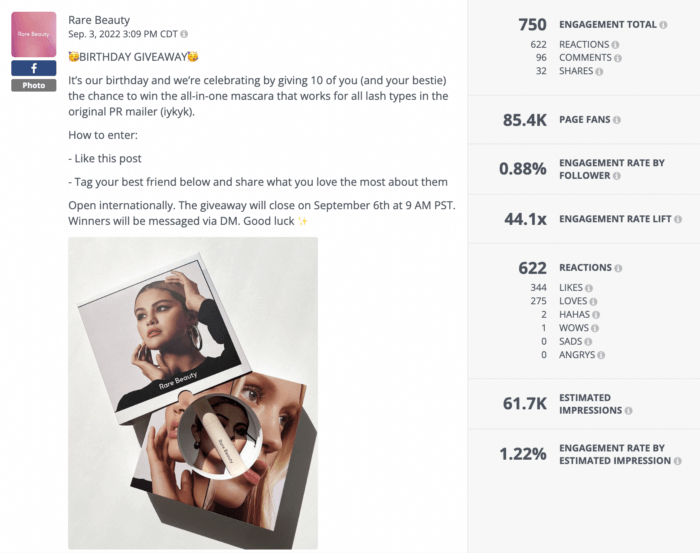
While giveaways have been less popular compared to previous years, they can still be an effective way to boost your engagement and let your Facebook audience know you’re still engaged and dedicated to them on this channel.
Facebook Best Practice #4: Optimize your posting frequency
If you rarely post on your brand’s Facebook page, you won’t see any real benefits to your business. But what about the opposite situation? On the other hand, posting too much can be harmful to brand engagement where you run into issues of oversaturating your audience with content. This will either cause more important content to get lost in the noise or alienate your audience altogether out of sheer annoyance.
What matters most is finding a posting frequency that works for you. If posting too little or too much are the extremes, what is the optimal posting limit for increasing engagement with your audience in 2023? While posting frequency varies by industry, the average number that brands across industries are posting is five posts per week.
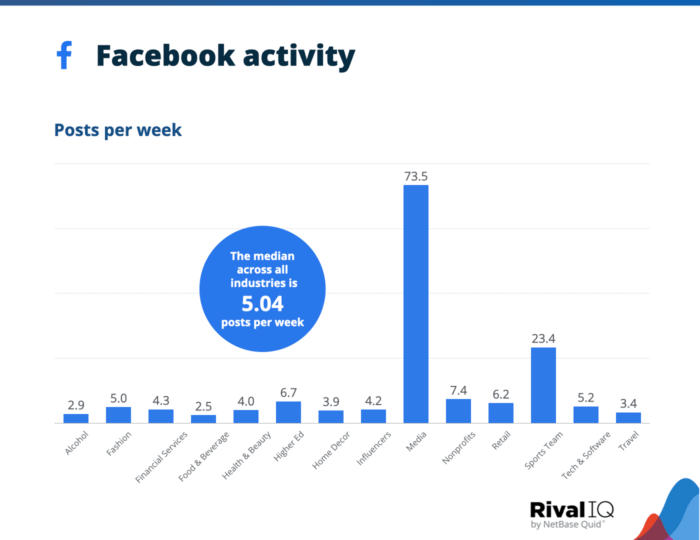
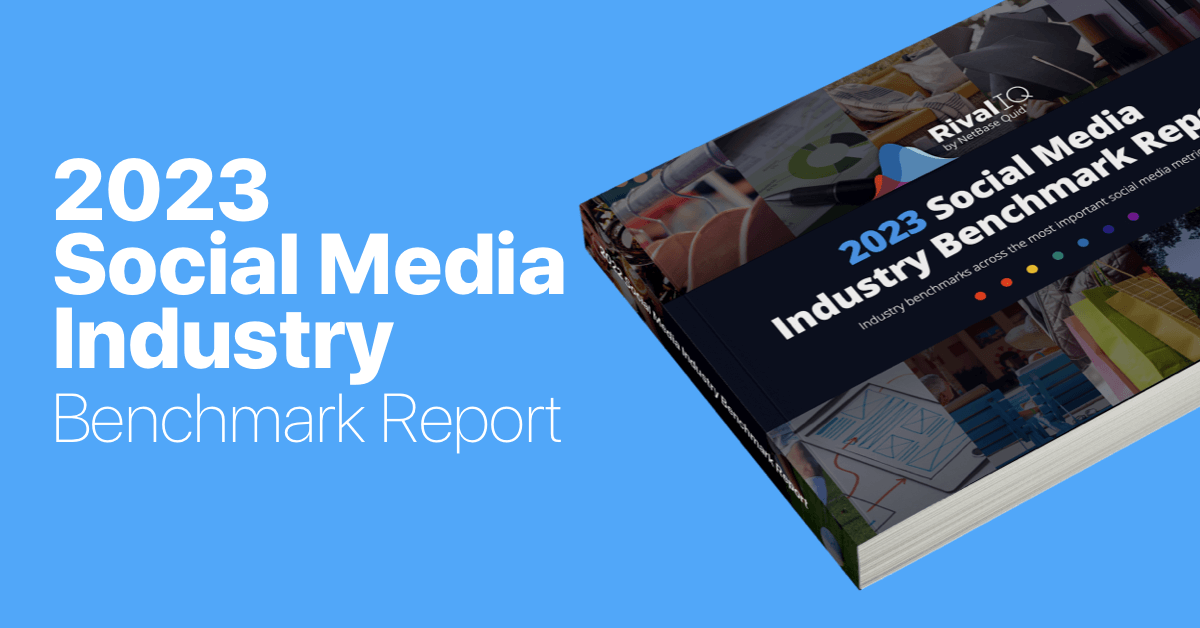
Want to dive into more Facebook metrics by industry?
Download the full reportDeciding how many times to post per day is relative to your return on investment. That’s why it’s crucial to track the clicks, impressions, and shares for your page, and Rival IQ has just the right tools to help you optimize your social strategy. Our platform will analyze your social channels and top-performing content to determine when the best times to post during the day are for your brand. Speaking of best times…
BONUS: What about the best times to post?
Great question! Luckily, we’ve done extensive research into this subject at Rival IQ and there are a few general takeaways you should consider for Facebook:
- Move away from lunchtime: Much like on Instagram, weekday mornings and afternoons see the highest concentration of posting, but don’t have much to show for themselves by way of engagement. Experiment with late night Facebook posts to see if you can catch your followers outside of work.
- Try posting on weekends: Brands are seeing above average engagement rates on Facebook on the weekends, especially in the evenings.
Outside of this, the best times to post on Facebook are specific to your brand and the historical performance of your page. This information is found in your Facebook Page Insights. Once you select “posts” in the Insights section, you’ll find a breakdown chart that shows average post traffic throughout the day so you can find the optimal times to post.
Facebook Best Practice #5: Implement a video strategy
It’s not enough to use images in your social media post lineup. If you’re only using images and not video to convey the power of your brand on Facebook, then you’re missing out on a huge marketing opportunity — specifically with Reels.
While Reels are huge on Instagram, you can get even more out of them by sharing your Reels on Facebook. After you post a Reel, you can automatically share it to your linked Facebook account to reach that audience without having to post twice. The video below from Siete Family Foods, a top health food brand on Facebook, is a Reel that the brand also shared on Instagram. This video generated an engagement rate that’s eight times better than the average engagement rate on Facebook.
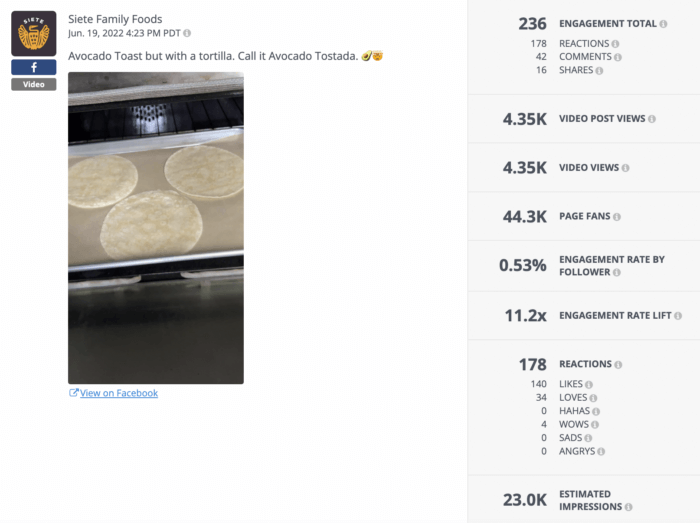
If you’re just developing your video strategy for Facebook in 2023, here are a few more best practices to follow:
- Create a short intro trailer for longer videos: Not everyone has minutes to figure out what you’re hoping to convey in your video before scrolling on. A short three- to five-second intro trailer that hooks your audience is the perfect way to keep them on the leash for the valuable content you’re looking to convey.
- Don’t go overboard on length: Nobody has time to watch a thirty-minute diatribe about your brand, product, or topic, especially while scrolling through Facebook. Keep your video length anywhere between one to five minutes to convey your message.
- Use the correct aspect ratio: Just like the optimal image sizes, Facebook also has an optimal video aspect ratio. Use a 4:5 aspect ratio when releasing content on this social platform.
As long as you stick to these best practices and keep your video content fresh, your audience should reward you with the engagement and clicks you’re looking for.
Facebook Best Practice #6: Take advantage of Meta Business resources
Facebook, which is now under the umbrella of Meta, offers countless resources directly on its website to help businesses and creators get the most out of the platform.
For instance, you can learn more about the latest updates and platform-specific tips for Meta Business Suite, which is the central place to manage your brand’s Facebook page and Instagram account.
There’s also Facebook for Creators, a dedicated resource for creators and brands. Facebook provides countless how-to guides, case studies, guidelines, and best practices for you to follow. Who better to take advice on using Facebook than the creators of the platform itself?
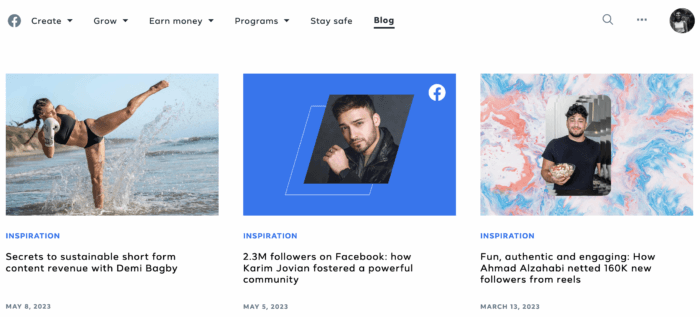
If anything, you should at least read through their “Get Started” resource to help you establish your brand as a significant force when it comes to video content creation. One thing to keep in mind is that this guide will lead your page down the path to becoming a video creators page and if that is not your only goal, make sure you skip over some of the steps that lead in that direction. Chances are you’ll use this resource as a way to find new ideas for content and promotion for your business rather than a tool to becoming the next big online influencer or commentator.
Facebook Best Practice #7: Use alt text
To make sure your content is accessible to everyone on Facebook, add alt text to your images. Alt text is the written text that’s embedded in an image’s HTML code and is used to describe the content of the image. Alt text is helpful for users who may be visually impaired and use screen reading tools. It can also provide context for all users if your image fails to load for any reason and helps search engines better categorize your content.
While Facebook automatically generates alt text if you don’t add your own, it’s usually pretty nondescript. To make sure your alt descriptions are painting an accurate picture of what’s being shown in the image, it’s best to create your own.
For example, the alt text on this photo shared by sparkling water brand Spindrift perfectly describes the photo while still weaving in its brand. The description says: “Two Spindrift cans laying atop a pile of apples and cinnamon revealing the new flavor for sparkling and spiked: Spiced Apple Cider.”
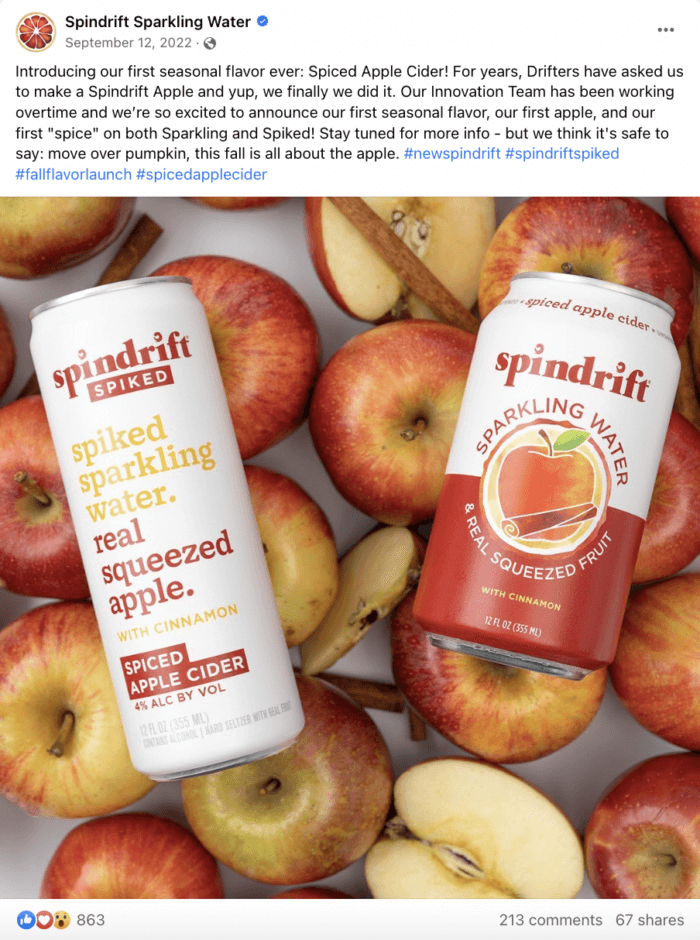
Facebook Best Practice #8: Make customer service a priority
Your Facebook page is more than just a giant digital billboard for you to share the latest company updates. It’s a platform for you to connect with your audience and offer support when followers reach out. Over 54% of people use Facebook to keep up with brands, and that includes reaching out for questions or support.
If you want to build engagement and trust between your brand and your audience, then make customer service a priority. Have a plan for how you’ll manage customer questions, inquiries, and feedback and how you’ll respond.
Being responsive on your brand’s Facebook page has a huge impact, especially if you respond in a timely fashion. Facebook will actually display a badge on your page denoting the fact that you are very responsive if you have:
- A response rate of 90% or more
- A response time of less than 15 minutes
Below is an example of the badge you’ll earn from Facebook for being responsive. If a potential customer sees this, they’ll trust that they can reach out for support.
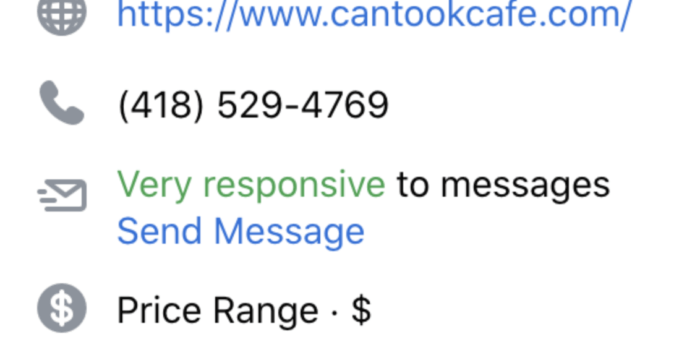
Being responsive is one of the easiest Facebook best practices to jump on, but answering all of your messages will require constant attention. Make sure all of your message notifications are turned on and someone on your team is responsible for monitoring your page’s activity. Answering messages on your page is the perfect way to connect with your audience on a granular level.
Engagement is a two-way street when it comes to social media — the more you engage with your audience, the more likely they are to feel connected to your brand.
Facebook Best Practice #9: Boost your highest performing posts
What if the popularity party could run for just a little bit longer? Boosting popular posts is a great way to double-dip on the engagement you receive and get your content in front of more eyes. Instead of relying on Facebook’s algorithm to build organic reach, you can pay Facebook to put your content in front of more people. Out of all of the Facebook best practices in this list, this one is the only one that’ll require a real monetary investment in the platform.
The key to boosting Facebook posts is to choose ones that already performed well. When you boost a high-performing post, you can target a wider audience so that people who don’t already follow you can also engage with it.
In the Facebook post from good culture, another top health food brand on Facebook, we can see in our analysis that the image was likely boosted (as indicated by the tag by the red arrow). While the engagement total was primarily made up of likes, we can see that the post also generated a decent number of comments and shares. It also gave the brand an engagement rate lift that was 32 times better than similar posts the brand shared.
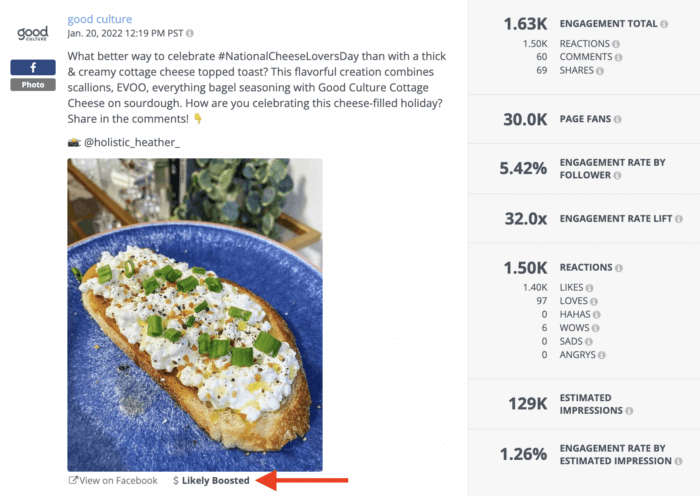
The process for boosting posts is also much easier than setting up a formal ad campaign. Here are the steps:
- Choose the post you want to boost
- Click “boost post”
- Choose which objective you’re looking to accomplish with this post: website visits, engagement, or direct messages
- Choose your CTA button
- Select your audience
- Set your budget and duration
When boosting your posts, you set the budget you are comfortable spending with the minimum spend set at $1 per day. The days of massive organic reach on Facebook may be over, but there are still opportunities to amplify your reach and boosting is an effective method.
Facebook Best Practice #10: Be authentic
Millennials and Gen Z are very quick to pick up on insincere and contrived marketing. Instead, these generations support brands that promote honesty, civic engagement, corporate responsibility, and real connection with their customers.
One easy way to connect to your audience, particularly a younger audience, is through relatable and candid content. This includes the use of features like Stories and Reels to release personable content about your brand, such as staff highlights, production processes, POV videos of events, and AMA (ask me anything) posts.
However, it’s not enough to just release a few videos and stories. The tone is everything when it comes to this kind of content, so relax and be your genuine self (or selves). Self-awareness and a relaxed tone go a long way, as does humor for many brands. Top-performing convenience store Kwik Trip offers an excellent example of how to tap into the authentic and relatable content that ties into your brand in the post below.
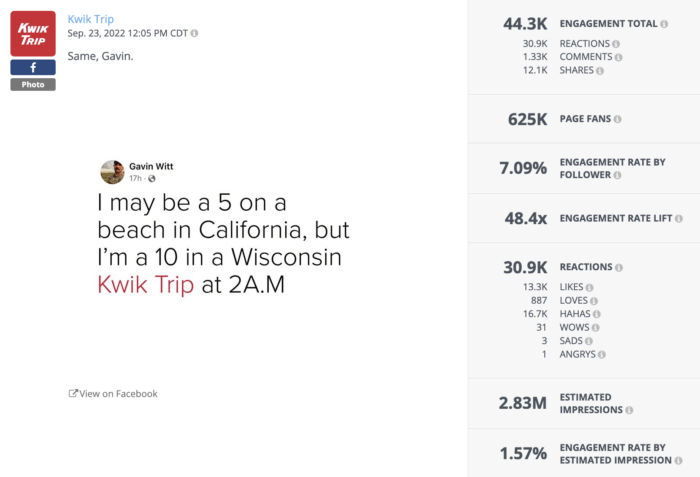
Final Note on Facebook Best Practices in 2023
Things are changing quickly and these Facebook best practices are expected to change along with it. The key is to always be aware of what the latest engagement rates are both across industries and within your specific industry so you have a benchmark to work towards. As different strategies and trends arise, it’s important to track and measure your efforts to see what’s working.
Facebook may be different than what it was a few years ago, but it continues to be an effective channel for communicating with your audience, sharing important updates, and cross-posting when it makes sense. Experiment with these tried and true Facebook best practices to boost your engagement on the channel in 2023.
This post was originally published in June 2021 and has since been updated.
